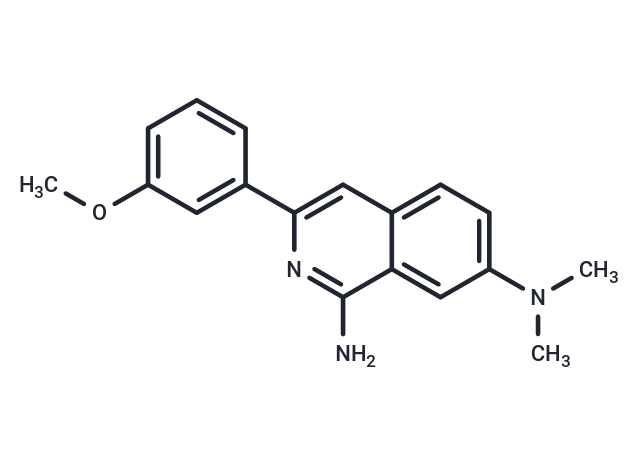Shopping Cart
- Remove All
 Your shopping cart is currently empty
Your shopping cart is currently empty

3-arylisoquinolinamine derivative is a compound with antitumor activity.

| Pack Size | Price | Availability | Quantity |
|---|---|---|---|
| 2 mg | $53 | 5 days | |
| 5 mg | $119 | 5 days | |
| 1 mL x 10 mM (in DMSO) | $107 | 5 days |
| Description | 3-arylisoquinolinamine derivative is a compound with antitumor activity. |
| Targets&IC50 | OVCAR-3 (ovary):14 nM , Pancreas PANC-1:19 nM , Kidney Caki-1:22 nM , Prostate PC3:19 nM , SNB19 (Glioblastoma):32 nM , MDA-MB-231 cells:21 nM , Colon HCT 116 cells:17 nM , SK-MEL-28 cells:32 nM |
| In vitro | 3-arylisoquinolinamine derivative (7b) shows more effective activity against Paclitaxel-resistant HCT-15 human colorectal cancer cell lines when compared to the original cytotoxic cancer drug, Paclitaxel. The cell cycle dynamics is analyzed by flow cytometry. Treatment of human HCT-15 cells with 3-arylisoquinolinamine derivative (7b) blocks or delays the progression of cells from the G0/G1 phase into the S phase, and induces cell death. 3-arylisoquinolinamine derivative (7b) inhibits the cell growth (IC50: 14 nM to 32 nM). In cell cycle analysis using HCT-15 cells, the treatment of 1 nM of 3-arylisoquinolinamine derivative (7b) displays a significant increase in G0/G1 phase at 24 h with a decrease in G2/M phase, but the increase of G0/G1 phase at 48 h is not significant. At a higher concentration of 3-arylisoquinolinamine derivative (7b) (10 nM), there are a significant increase in G0/G1 phase and a decrease in G2/M phase, and the emergence of sub-G1phase, at both 24 h and 48 h. 3-arylisoquinolinamine derivative (7b) blocks or delays the progression of cells from the G0/G1 phase into S phase, and induces cell death [1]. 3-arylisoquinolinamine derivative (compound 13; IC50: 15 nM in HCT-15 cells, 17 nM in HCT116 cells) shows potent antiproliferative activities with IC50 value in the low nanomolar range in both cells and higher antitumor activities than that of Paclitaxel against Paclitaxel-resistant HCT-15 colorectal cancer cells [2]. |
| In vivo | The 3-arylisoquinolinamine derivative demonstrates superior antitumor efficacy, achieving 69.2% inhibition of tumor growth in an animal model, outperforming the control drug, Paclitaxel, which exhibits 48.8% inhibition [2]. |
| Animal Research | The six-week-old female athymic mice (BALB/c nu/nu) are used. All study medications (vehicle control, Paclitaxel: 10 mg/kg/day, 3-arylisoquinolinamine derivative: 10 mg/kg/day) are given by intraperitoneal injections three times per week starting from day 10 and ending on day 29 after inoculation of HCT 15 cells. To quantify tumor growth, three perpendicular diameters of the tumors are measured with calipers every 3-5 days, and the bodyweight of the mice was monitored for toxicity. The tumor volume is calculated [2]. |
| Molecular Weight | 293.36 |
| Formula | C18H19N3O |
| Cas No. | 1029008-71-6 |
| Relative Density. | 1.190 g/cm3 (Predicted) |
| Storage | Powder: -20°C for 3 years | In solvent: -80°C for 1 year | Shipping with blue ice. | |||||||||||||||||||||||||||||||||||
| Solubility Information | DMSO: 50 mg/mL (170.44 mM), Sonication is recommended. | |||||||||||||||||||||||||||||||||||
Solution Preparation Table | ||||||||||||||||||||||||||||||||||||
DMSO
| ||||||||||||||||||||||||||||||||||||

Copyright © 2015-2025 TargetMol Chemicals Inc. All Rights Reserved.